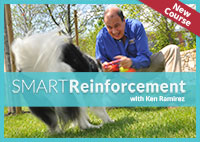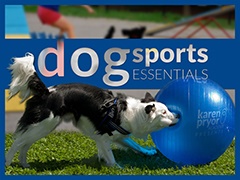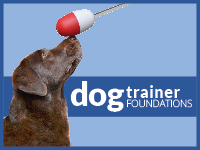Collective wisdom from the ClickerExpo family
The trainers and enthusiasts who attend ClickerExpo come to increase their understanding and strengthen their skills. They are also a rich source of expertise and practical advice for each other as well as newcomers to clicker training and pet management.

We've invited our Expo family to share their most trusted approaches to training common life skills, those basic and necessary canine behaviors that enable people and dogs to live together in peace.
Cindy Williams, Training Coordinator for Susquehanna Service Dogs in Pennsylvania, offers these positive steps to teaching a puppy to greet strangers gently and appropriately. While Cindy's approach is designed for service dogs, who must continue to focus on their assistance tasks while interacting with strangers, it can be adapted for pet dogs who must maintain control despite the excitement of meeting new people.
Greeting Strangers 101
Contributed by Cindy Williams
Goal: The puppy will be able to pay attention to handler, while being patted by a stranger.
Service dogs are out in the real world every day. As service dog trainers, we realize it is impossible for people to keep their hands off these delectable animals, so it's important to teach the dogs how to handle greetings with strangers. Our goal is that the dog should be completely focused on their handler while being patted by a stranger with no additional cues necessary. Believe it or not, this is not a difficult thing to train; all it requires is practice for the handler, clicker training, a bit of classical conditioning, practice for the handler, and repetition for the dogs.
The challenge for the handler will be in preparation and coordination. As a stranger approaches your dog, grab a fistful of dog treats out of your treat bag. When the stranger starts to bend over to pat your dog, feed your dog one treat at a time in rapid succession.
After about 8 to 10 treats one after the other, pause for a moment (a count of one) and have your clicker ready. If in that pause your dog looks up at you, as if to say "why did you stop feeding me?" click immediately and give several treats (one at a time).
Pause and try again. Do not attempt a long pause at this point; just a moment of looking at you. Click again. If the dog does not look at you and instead chooses to get excited about the stranger, immediately start feeding treats again. Either you paused for too long (and missed that moment of attention), your treats are not that exciting (fruit loops are boring!), or the puppy needs more repetitions of just being patted by a stranger while being fed by you.
In addition to coordinating all of the above, train yourself to be able to talk politely to the stranger who inevitably will be asking you questions about your dog. Thankfully the questions are usually routine (name, age, breed) and won't require too much concentration on your part. With luck, by the time they have begun to ask you training questions, they have stopped petting your dog. This brings us to the next important point in this exercise: as soon as the stranger ceases greeting your dog, you must stop the feeding as well. Beware of feeding your pup absentmindedly if you get into an involved discussion with the stranger.
Over time and with repetitions, slowly decrease the amount of starter treats needed until they are no longer necessary. Then simply click and treat for attention. If at any point this wonderful attention falls apart, simply go back a few steps and remind your pup that a stranger equals food. Please note that in this exercise, you do not give any cues to your dog! Try not to talk while you're training this behavior. Remember, what we want is a dog that learns that a stranger petting me means I should look at you, because you're going to feed me. No additional cues necessary.
At Susquehanna Service Dogs, we have found this technique to be extremely effective. Every dog is different; some can get more excited than others, but with most dogs we find excellent results within 3 to 5 repetitions.
We've also found that the effect of the technique can be exceedingly long-lived. Gideon and Oliver (Labradors) were raised using this technique consistently. At 18 months of age, both dogs were designated to become demonstration dogs for our program. With this new position, however, our criteria for polite greetings changed. These dogs were now ambassadors for Susquehanna Service Dogs. They were meeting potential donors and children and adults with special needs, and we wanted them to greet these people enthusiastically. After we stopped reinforcing attention to the handler during greetings, both dogs continued being very polite and restrained during greetings, turning to stare resolutely at their handlers.
Nancy Fierer, Program Director
3700 Vartan Way
Harrisburg, PA 17110
nfierer [at] kss [dot] org
www.keystonehumanservices.org/ssd/ssd.php








Fear of strangers
Do you recommend this same technique if the dog is afraid of strangers?
Post new comment